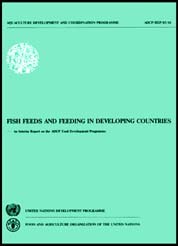
AQUACULTURE DEVELOPMENT AND COORDINATION PROGRAMME
UNITED NATIONS DEVELOPMENT PROGRAMME
FOOD AND AGRICULTURE ORGANIZATION OF THE UNITED NATIONS
ROME, 1983
|
The designations employed and the presentation of material in this publication do not imply the expression of any opinion whatsoever on the part of the Food and Agriculture Organization of the United Nations concerning the legal status of any country, territory, city or area or of its authorities, or concerning the delimitation of its frontiers or boundaries. |
All rights reserved. No part of this publication may be reproduced, stored in a retrieval system, or transmitted in any form or by any means, electronic, mechanical, photocopying or otherwise, without the prior permission of the copyright owner. Applications for such permission, with a statement of the purpose and extent of the reproduction, should be addressed to the Director, Publications Division, Food and Agriculture Organization of the United Nations, Via delle Terme di Caracalla, 00100 Rome, Italy.
© FAO 1983
|
ABSTRACT Under ADCP's Fish Feed Development Programme, a survey of the availability of ingredients for fish and shellfish feeds was undertaken in 11 countries. Information on the various feed stuffs, their composition, nutritional value, prices and availability are summarized. Although some of the feed stuffs have anti-nutritional or toxic factors, the majority of them are useful as ingredients in fish and shellfish diets. Making use of the facilities in the FAO/UNDP Network of Aquaculture Centres and other projects and the nutrient specifications for cultivated species, a number of least-cost feeds using locally available ingredients were formulated, prepared and tested. A micro-encapsulated egg diet proved efficient as a larval feed for rohu, Clarias, sandgoby and Pangasius. The results of feeding experiments with fingerlings and adult fish are summarized. Based on experience so far, a number of 24-30 percent protein diets for warm water fishes and 40-50 percent protein diet for rainbow trout fry, fingerlings and adults are proposed. The existing feed milling industries in the countries surveyed are briefly described and their ability to undertake fish feed manufacture discussed. |
This electronic document has been scanned using optical character recognition (OCR) software and careful manual recorrection. Even if the quality of digitalisation is high, the FAO declines all responsibility for any discrepancies that may exist between the present document and its original printed version.
2.1 Feedstuffs for aquaculture
2.1.1 Legumes
2.1.2 Miscellaneous fodder plants
2.1.3 Roots and tubers
2.1.4 Cereals and cereal by-products
2.1.5 Oilcakes and oil meals
2.1.6 Feeds of animal origin
2.1.7 Miscellaneous feedstuffs2.2 Composition of feedstuffs
2.3 Feed quality2.3.1 Protein quality
2.3.2 Anti-nutritional and toxic factors
3.1 Egypt
3.2 India
3.3 Malaysia
3.4 Mexico
3.5 Nepal
3.6 Nigeria
3.7 The Philippines
3.8 Sri Lanka
3.9 Thailand
3.10 Tunisia
3.11 Venezuela
3.12 Feed ingredient prices
4.0 FORMULATED FEEDS FOR AQUACULTURE IN THE TROPICS
4.1 Micro-encapsulated larval diet
4.2 Diets for warm water omnivores
4.2.1 Carps and Tilapia
4.2.2 Pacu (Prochilodus spp.) and Tambaqui (Colossoma spp.)4.3 Diets for warm-water carnivores
4.3.1 Catfishes (Clarias spp., Ictalurus punctatus)
4.3.2 Grouper (Epinephelus tauvina), sea bass (Lates calcarifer, Dicentrarchus labrax), sea bream (Sparus auratus)
4.3.3 Other diet formulations for warm water species
5.0 MANUFACTURED FEEDS FOR AQUACULTURE
5.1 Survey of the feed manufacturing industry
5.2 Recent developments in pelleted feed manufacture
5.3 Feasibility of using manufactured feeds for aquaculture